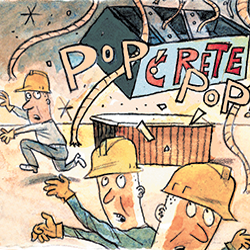|
fixing snafus

illustration: Regan Dunnick
Winds of Change
With just 12 hours to go before the show opened, we found ourselves in a tent in the middle of a marathon-length storm with no way to batten down the hatches.
Plan A
Mother Nature can be one cruel mistress, capable of outsmarting even the wiliest weather-forecasting professionals. I was recently reminded of her ability to turn on her heels and roar during the Interpack show in Dusseldorf, Germany.Beckhoff Automation GmbH & Co. KG, a provider of open-automation systems, had hired my company to design and craft a stand for its presence at Interpack. However, reps at Beckhoff had failed to secure a booth space shortly after the previous year's show. By the time they attempted to purchase a slice of concrete for the current iteration, the indoor section of the exhibit hall was completely sold out. Since there was no room for them at the proverbial inn, their only option was the outdoor manger, so to speak. Thus, about two months before the show was set to open in May, my team began designing a roughly 985-square-foot stand that would be positioned in an outdoor area at Messe Dusseldorf between the main exhibition halls. Since the average temperature in May is only 57 degrees, we opted for a tent-like structure reinforced with a special metal frame. Rather than plain old tent canvas, the outer skin would comprise a more rigid material in a bold Beckhoff-red color. Its roof was almost flat, so the effect would be that of a striking, 23-foot-tall branded cube. To ensure that the structure would withstand any spring storms, we strengthened the design to handle a wind load of eight out of 12 on the Beaufort Scale. This meant the structure would weather a "fresh gale" rating with sustained winds of up to 46 mph. As the show grew closer, the weather reports called for only a light wind during the event's five-day run. Our setup crew arrived to sunny skies, installation went off without a hitch, and the client was pleased with the strong, eye-catching cube. However, less than 24 hours before the show opened, Mother Nature had a bit of a tantrum. A massive thunderstorm blew into town and started to howl, growl, and wail. Hail, thunder, lightening, and rain covered the fairgrounds, and wind gusts topped 70 mph. At times, the storm was an 11 on the Beaufort Scale, which is one step below a hurricane. Initially, we tied down what we could and figured we would just wait for the storm to pass and then assess the damage and make repairs before the show opened in the morning. But Mother Nature had other ideas. Not long after the deluge began, we rechecked the weather reports, which had changed dramatically. This she-devil of a storm was expected to sit over Dusseldorf for the next five days, dumping rain and spewing vicious winds for the duration of the event. With just 12 hours to go before the show opened, we found ourselves in a tent in the middle of a massive, marathon-length storm with no way to batten down the hatches. Plan B
Our creative team huddled together to devise a solution. We knew the metal structure would hold strong in winds under 46 mph, but anything over that, and the pressure of the wind-forced canvas against the framing might be too much. It was possible that our structure would literally be gone with the wind. We certainly couldn't take down the tent completely and expose the internal components to the rain, but we needed a plan for when the storm ramped up in intensity. After what seemed like an eternity of brainstorming, we figured the best way to appease Mother Nature was to work with her rather than against her. In other words, we decided that when she really got going, we'd raise some of the tent sides to allow the wind to move through the structure, thereby avoiding collapse. It wasn't ideal, but it was far better than the alternative. First, we moved all critical interior components away from the tent sides and toward the middle of the structure where the rain couldn't reach them, even if the sides were open. Next, we cut the tent sides into roughly 40-foot panels, rented some scissor lifts, and attached an anemometer (a device used for measuring wind speed) to the wind-facing side of the tent. Then the real fun began. Throughout the run of the show, eight staffers took turns watching the anemometer for changes in wind speed. Whenever it crept above 46 mph, everyone sprang into action. Scissor lifts zipped into position along the tent sides and aided crew members in rolling up the 40-foot sections and securing them to a cross section of the metal structure. Meanwhile, other staffers tied down anything that could take flight, enabling the wind to blow through the structure instead of toppling the whole shebang into a heap. Granted, we got a little spray inside when Mother Nature really started howling, but with minimal effort and a few towels, things were right as rain again. Once the wind subsided, we rolled the flaps back down and secured them into place. But before long, the wind whipped up again, and we restarted the whole process. This choreographed routine went on for five days, with performances occurring up to 12 times per day. During the show, the storm dumped twice as much rain as the local average rainfall for March and April combined. Many roads were flooded, and more than 33,000 people were without electricity. But the show went on – and our tent never took flight. In fact, the fair was a huge success for Beckhoff. Hoards of rain-soaked fairgoers used the tent as a shelter throughout the storm, allowing staffers to spend considerable time with visitors who were immersed in the Beckhoff environment and surrounded by its offerings. So as is often the case in life and in trade shows, it was better to go with the flow than stand firm and risk breaking apart in the storm. — Katja Ueberholz, social media and public relations, Ueberholz GmbH, Wuppertal, Germany
TELL US A STORY
Send your Plan B exhibiting experiences to Linda Armstrong, larmstrong@exhibitormagazine.com.
|
|
|
||||||||||||||||||||||||||||
|
|
||||||||||||||||||||||||||||
|
TOPICS Measurement & Budgeting Planning & Execution Marketing & Promotion Events & Venues Personal & Career Exhibits & Experiences International Exhibiting Resources for Rookies Research & Resources |
MAGAZINE Subscribe Today! Renew Subscription Update Address Digital Downloads Newsletters Advertise |
FIND IT Exhibit Producers Products & Services All Companies Get Listed |
EXHIBITORLIVE Sessions Exhibit Hall Exhibit at the Show Registration |
ETRAK Sessions Certification F.A.Q. Registration |
EDUCATION WEEK Overview Sessions Hotel Registration |
CERTIFICATION The Program Steps to Certification Faculty and Staff Enroll in CTSM Submit Quiz Answers My CTSM |
AWARDS Exhibit Design Awards Portable/Modular Awards Corporate Event Awards Centers of Excellence |
NEWS Associations/Press Awards Company News International New Products People Shows & Events Venues & Destinations EXHIBITOR News |
||||||||||||||||||||
|
||||||||||||||||||||||||||||






